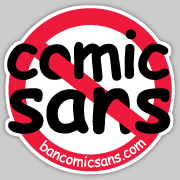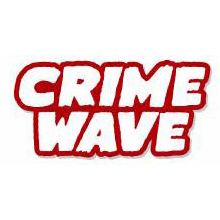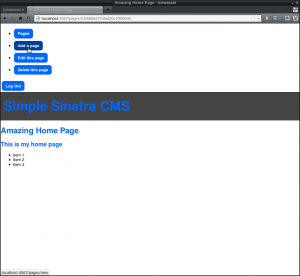If you ask designers what their least favourite font is, often the reply will be Comic Sans. It is classified as a casual font and was initially designed by Vincent Connare to look like the fonts used in comic books. You see it frequently on fliers, posters and menus, and let’s be honest it just screams AMATEUR! There can’t be too many fonts that are the butt of a joke either: Comic Sans walks into a bar, bartender says, ‘We don’t serve your type.’
 Thankfully, Comic Sans is not one of the fonts considered “web safe” or I’m sure we’d see it abused all around the web. There is even a web site dedicated to its outright obliteration. Ban Comic Sans, which has the excellent tag line “Putting The Sans In Comic Sans”, hosts an online petition you can sign to show your solidarity with the movement.
But enough about that font. This article is about alternatives to Comic Sans, and really about pointing out some excellent fonts that are much more in keeping with style of typography used in comic books. Traditionally, all comic books were hand-lettered, although the type was controlled and quite mechanical. The eight fonts I’ve picked out below are created in this style, and there are literally hundreds available. Most of the sites linked to below have more than one comic font for download. Some are more suitable for headings in web design while others could be used for small paragraphs of text on print material. In no particular order here are some of the free fonts for you to add some comic style to your web site or graphic project;
Blambot fonts are one of the best known type foundries for comic style fonts and they have many free and commercial fonts on their site. I’ve picked out two. Crime Wave is this month’s free font,
Thankfully, Comic Sans is not one of the fonts considered “web safe” or I’m sure we’d see it abused all around the web. There is even a web site dedicated to its outright obliteration. Ban Comic Sans, which has the excellent tag line “Putting The Sans In Comic Sans”, hosts an online petition you can sign to show your solidarity with the movement.
But enough about that font. This article is about alternatives to Comic Sans, and really about pointing out some excellent fonts that are much more in keeping with style of typography used in comic books. Traditionally, all comic books were hand-lettered, although the type was controlled and quite mechanical. The eight fonts I’ve picked out below are created in this style, and there are literally hundreds available. Most of the sites linked to below have more than one comic font for download. Some are more suitable for headings in web design while others could be used for small paragraphs of text on print material. In no particular order here are some of the free fonts for you to add some comic style to your web site or graphic project;
Blambot fonts are one of the best known type foundries for comic style fonts and they have many free and commercial fonts on their site. I’ve picked out two. Crime Wave is this month’s free font,
 and Letter-o-matic
and Letter-o-matic
 Onomato Shark is available from Sharkragon on DeviantArt
Onomato Shark is available from Sharkragon on DeviantArt
 Robot Johnny is the web site of John Martz, a Toronto based cartoonist and illustrator. John provides several fonts under the licence of “Toyware” i.e. the fonts are free for non-commercial use, but if you plan on making money using them, then he requests that you pay a license fee in the form of a toy, book, or something fun.
Turkey Sandwich by Robot Johnny
Robot Johnny is the web site of John Martz, a Toronto based cartoonist and illustrator. John provides several fonts under the licence of “Toyware” i.e. the fonts are free for non-commercial use, but if you plan on making money using them, then he requests that you pay a license fee in the form of a toy, book, or something fun.
Turkey Sandwich by Robot Johnny
 Earth’s Mightiest from Iconian Fonts
Earth’s Mightiest from Iconian Fonts
 Helsinki is the font used in word balloons in the web comic Dubmarine by Vic Fieger. It is a refined version of the Vic’s own handwriting, altered to appear more similar to traditional ‘comic book’ lettering.-
Helsinki is the font used in word balloons in the web comic Dubmarine by Vic Fieger. It is a refined version of the Vic’s own handwriting, altered to appear more similar to traditional ‘comic book’ lettering.-
 ZeroGene by Teabeer studios
Teabeer Fonts are free for non commercial or indie comics use. You will need a licence if you want to use them commercially.
ZeroGene by Teabeer studios
Teabeer Fonts are free for non commercial or indie comics use. You will need a licence if you want to use them commercially.
 The Ray Johnson font by K-Type is free for personal use
The Ray Johnson font by K-Type is free for personal use
 To conclude this article I’d like to mention one other site — Comic Book Fonts. I couldn’t find any free fonts on it, but the commercial ones on it are amazing. It includes fonts created by Dave Gibbons who did the lettering on the Watchmen.
Have you come across other comic fonts you really like? Have you used them in design projects before?
To conclude this article I’d like to mention one other site — Comic Book Fonts. I couldn’t find any free fonts on it, but the commercial ones on it are amazing. It includes fonts created by Dave Gibbons who did the lettering on the Watchmen.
Have you come across other comic fonts you really like? Have you used them in design projects before?
Frequently Asked Questions about Comic Sans Font
Why is Comic Sans often criticized in the design community?
Comic Sans, despite its popularity among some users, is often criticized in the design community for its perceived lack of professionalism and overuse. Many designers argue that it lacks the sophistication and versatility of other fonts, making it unsuitable for most professional or formal contexts. Additionally, its overuse in inappropriate contexts, such as business communications or official documents, has led to a backlash against the font.
Is Comic Sans a good font for logos?
While Comic Sans can be used in logos, it’s generally not recommended for professional or corporate logos. The font’s casual and playful nature may not convey the right message for a business. However, it could be suitable for logos related to children’s products, casual businesses, or creative projects where a fun and informal tone is desired.
Can I use Comic Sans for commercial purposes?
Yes, Comic Sans can be used for commercial purposes as it’s a proprietary font owned by Microsoft. However, it’s important to consider the appropriateness of the font for your specific project. Its casual and playful nature may not be suitable for all commercial uses.
Are there any alternatives to Comic Sans?
Yes, there are many alternatives to Comic Sans that maintain a similar playful and informal tone. Some of these include Chalkboard, Kristen ITC, and Comic Neue. These fonts offer a similar feel to Comic Sans but with a slightly more refined and professional appearance.
Why is Comic Sans popular despite the criticism?
Comic Sans is popular for its friendly and informal appearance, which can make text seem more approachable and less intimidating. It’s often used in contexts related to children or education, and in informal communications where a more relaxed tone is desired.
Is Comic Sans a web-safe font?
Yes, Comic Sans is considered a web-safe font. This means it’s commonly installed across many systems, ensuring that it will display consistently across different browsers and devices.
When was Comic Sans created and why?
Comic Sans was created in 1994 by Vincent Connare, a typographer at Microsoft. It was originally designed for a children’s computer program called Microsoft Bob, to create a friendly and informal tone.
Is Comic Sans suitable for dyslexic readers?
Some studies suggest that Comic Sans, with its unique character shapes and wide spacing, can be easier for dyslexic readers to decipher. However, it’s important to note that readability can vary greatly among individuals, and what works for one person may not work for another.
Can I modify Comic Sans for my own use?
As a proprietary font owned by Microsoft, modifying Comic Sans without permission would likely infringe on Microsoft’s copyright. If you need a modified version of the font, it’s recommended to seek out a similar, open-source font that allows for modification.
How can I use Comic Sans effectively?
To use Comic Sans effectively, it’s important to consider the context and audience. The font is best suited for informal, playful, or child-friendly contexts. Using it inappropriately, such as in a formal business document, can lead to criticism.
Jennifer Farley is a designer, illustrator and design instructor based in Ireland. She writes about design and illustration on her blog at Laughing Lion Design.




